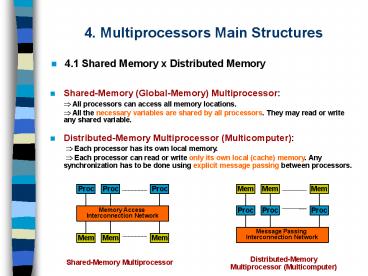4. Multiprocessors Main Structures - PowerPoint PPT Presentation
1 / 6
Title:
4. Multiprocessors Main Structures
Description:
... synchronization has to be done using explicit message passing between processors. ... Processors execute different instructions on different data. ... – PowerPoint PPT presentation
Number of Views:36
Avg rating:3.0/5.0
Title: 4. Multiprocessors Main Structures
1
4. Multiprocessors Main Structures
- 4.1 Shared Memory x Distributed Memory
- Shared-Memory (Global-Memory) Multiprocessor
- ? All processors can access all memory
locations. - ? All the necessary variables are shared by all
processors. They may read or write any shared
variable. - Distributed-Memory Multiprocessor
(Multicomputer) - ? Each processor has its own local memory.
- ? Each processor can read or write only its own
local (cache) memory. Any synchronization has to
be done using explicit message passing between
processors.
Mem
Mem
Mem
Proc
Proc
Proc
Proc
Proc
Proc
Memory Access Interconnection Network
Message Passing Interconnection Network
Mem
Mem
Mem
Distributed-Memory Multiprocessor (Multicomputer)
Shared-Memory Multiprocessor
2
4. Multiprocessors Main Structures
- 4.1 Shared Memory x Distributed Memory
- Shared memory multiprocessors always have local
cache memories private to each processor. This
reduces global memory conflicts. As the size of
the cache memory increases, then the usefulness
of global memory is reduced to the buffering of
interprocess data (Message Passing Interconnect
Network). - Concurrent processes reside on various
processors. When some processors fail, the
remaining processors can continue the work,
though at a lesser throughput, but ensuring high
availability. - Recovery and process redistribution after a
failure is more difficult in distributed-memory
multiprocessors.
3
4. Multiprocessors Main Structures
- 4.2 Fine Grain x Coarse Grain
Grain refers to the number of instructions
executed in a processor before synchronizing or
communicating some data with another
processor. Fine-grain parallel processing
involves synchronizing the processors after few
instructions. Coarse-grain parallel processing
involves synchronizing the processors after tens
of thousands of instructions. Medium-grain
parallel processing has characterized a grain
size somewhere in the middle, for example,
several hundred instructions between
synchronizations.
4
4. Multiprocessors Main Structures
- 4.3 Moderate Parallel x Massively Parallel
- Moderate Parallel Processing
- architecture using 10 to 100 processors.
- Massively Parallel Processing
- architecture using hundreds of processors.
5
4. Multiprocessors Main Structures
- 4.4 SIMD x MIMD
- SIMD Single Instruction Multiple Data Processor.
- - A central controller broadcasts the same
instruction to different processors, each
processor then executes the instruction on its
data. - - Some processors can be masked from the
instruction by appropriately setting some mask
registers at each processor. - MIMD Multiple Instruction Multiple Data
Processor. - - Processors execute different instructions on
different data. - - Shared-memory MIMD multiprocessors are
programmed assuming that all the necessary
variables are shared by all processors, and that
they may read or write any shared variable. - - Distributed-memory MIMD multiprocessors are
programmed assuming that each processor can read
or write only its own local memory. Any
synchronization has to be done using explicit
message passing between processors.
6
4. Multiprocessors Main Structures
- 4.5 Topology of Interconnect
- Typical interconnection networks include
- BUS
- CROSSBAR
- MULTISTAGE
- MESHES
- TREES
- HYPERCUBES































